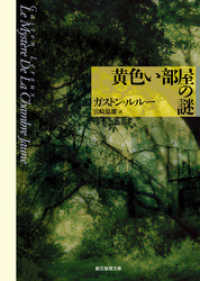- ホーム
- > 洋書
- > 英文書
- > History / World
Full Description
Changes to the landscape of higher education in the United States over the past decades have urged scholars grappling with issues of privilege, inequality, and social immobility to think differently about how we learn and deliberate. Thinking Together is a multidisciplinary conversation about how people approached similar questions of learning and difference in the nineteenth century.
In the open air, in homes, in public halls, and even in prisons, people pondered recurring issues: justice, equality, careers, entertainment, war and peace, life and death, heaven and hell, the role of education, and the nature of humanity itself. Paying special attention to the dynamics of race and gender in intellectual settings, the contributors to this volume consider how myriad groups and individuals—many of whom lived on the margins of society and had limited access to formal education—developed and deployed knowledge useful for public participation and public advocacy around these concerns. Essays examine examples such as the women and men who engaged lecture culture during the Civil War; Irish immigrants who gathered to assess their relationship to the politics and society of the New World; African American women and men who used music and theater to challenge the white gaze; and settler-colonists in Liberia who created forums for envisioning a new existence in Africa and their relationship to a U.S. homeland. Taken together, this interdisciplinary exploration shows how learning functioned not only as an instrument for public action but also as a way to forge meaningful ties with others and to affirm the value of an intellectual life.
By highlighting people, places, and purposes that diversified public discourse, Thinking Together offers scholars across the humanities new insights and perspectives on how difference enhances the human project of thinking together.
Contents
Contents
Acknowledgments
Introduction (Angela G. Ray and Paul Stob)
Part 1: Disrupting Narratives
1. The Portable Lyceum in the Civil War (Ronald J. Zboray and Mary Saracino Zboray)
2. Women's Entrepreneurial Lecturing in the Early National Period (Granville Ganter)
3. Mobilizing Irish America in the Antebellum Lecture Hall (Tom F. Wright)
4. Authentic Imitation or Perverse Original? Learning About Race from America's Popular Platforms (Kirt H. Wilson and Kaitlyn G. Patia)
Part 2: Distinctive Voices
5. A Lyceum Diaspora: Hilary Teage and a Liberian Civic Identity (Bjørn F. Stillion Southard)
6. Secret Knowledge, Public Stage; Joseph Smith's King Follett Discourse (Richard Benjamin Crosby)
7 .The "Perfect Delight" of Dramatic Reading: Gertrude Kellogg and the Post-Civil War Lyceum (Sara E. Lampert)
8. Talking Music: Amy Fay and the Origins of the Lecture Recital (E. Douglas Bomberger)
9. Hinduism for the West: Swami Vivekananda's Pluralism at the World's Parliament of Religions (Scott R. Stroud)
Conclusion: Placing Platform Culture in Nineteenth-Century American Life (Carolyn Eastman)
Notes
List of Contributors
Index








